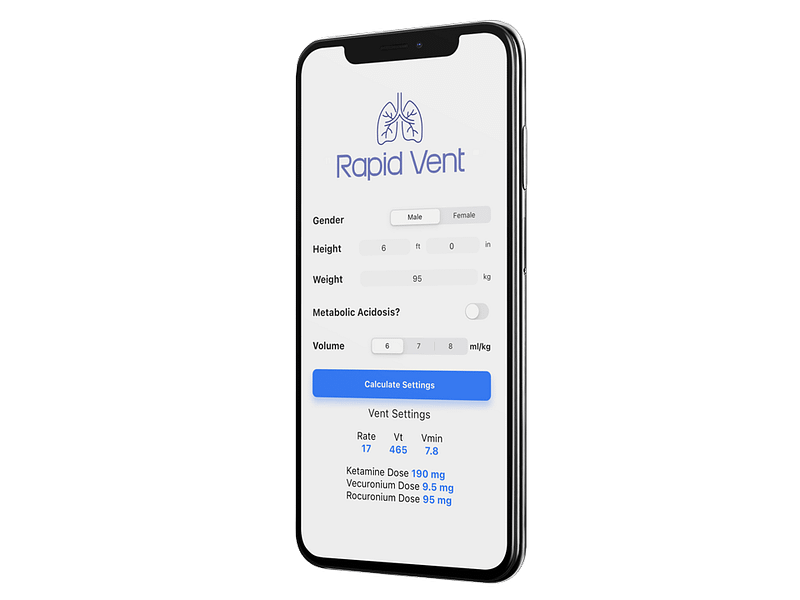Best Tidal Volume Calculator For Ventilators – Rapid Vent Calculator
As a respiratory care professional, you understand that accurate tidal volume delivery is critical for patients on mechanical ventilation. However, calculating the appropriate tidal volume can be a time-consuming and challenging task. That’s where the Rapid Vent Calculator, the best tidal volume calculator for ventilators, comes in. By automating tidal volume estimation, this tool can help you make more informed decisions and improve patient outcomes.
Key Takeaways
- The Rapid Vent Calculator is the best tidal volume calculator for ventilators.
- Accurate tidal volume delivery is crucial for patients on mechanical ventilation.
- Calculating the appropriate tidal volume can be a time-consuming and challenging task.
- The Rapid Vent Calculator can automate tidal volume estimation, improving efficiency and patient outcomes.
- By using the Rapid Vent Calculator, you can make more informed decisions in respiratory care for patients on mechanical ventilation.
Importance of Tidal Volume Calculation in Mechanical Ventilation
If you or someone you know is on mechanical ventilation due to respiratory distress, then it is crucial to understand the significance of tidal volume calculation in this process. Simply put, tidal volume refers to the amount of air a patient inhales and exhales with each breath. Inadequate delivery of tidal volume can affect oxygenation, lung function, and overall respiratory status, leading to serious complications. Therefore, accurate tidal volume delivery is critical for patients on mechanical ventilation.
When a patient is put on mechanical ventilation, the machine delivers a specific volume of air with each breath. This volume needs to be adjusted to accommodate the patient’s ideal body weight, respiratory condition, and other factors. Incorrect delivery of tidal volume can lead to lung injuries, such as barotrauma or volutrauma, and can increase the risk of mortality.
Moreover, tidal volume calculation is essential for monitoring and adjusting ventilator settings, as respiratory conditions can change rapidly. For instance, if a patient’s respiratory status improves, the tidal volume can be reduced gradually to minimize the risk of lung injury, leading to improved outcomes.
Overall, the proper calculation and delivery of tidal volume are crucial aspects of mechanical ventilation. It is essential to work with your healthcare team to ensure that the appropriate tidal volume is provided for your respiratory condition.
Understanding Tidal Volume and its Calculation
When patients require mechanical ventilation, tidal volume calculation is critical in delivering adequate and safe ventilation. Tidal volume refers to the amount of air moved in and out of the lungs with each breath. The calculation of tidal volume for each patient involves several factors, including their respiratory condition and size.
The Calculation of Tidal Volume
The calculation of tidal volume involves determining the appropriate amount of air to be delivered with each breath to maintain proper gas exchange in the lungs. The calculation of tidal volume for mechanical ventilation typically relies on a patient’s ideal body weight, which is based on their height. It is essential to know that the ideal body weight calculation may not be accurate for patients with a high or low muscle mass, fluid accumulation, obesity, or other conditions.
In addition to ideal body weight, factors such as age, gender, and respiratory condition also play a role in determining the appropriate tidal volume for a patient. A higher tidal volume can be harmful to a patient’s lungs and can lead to barotrauma, while a lower tidal volume may result in inadequate gas exchange and hypoxia.
The Impact of Tidal Volume on Patients
Delivering the right tidal volume is crucial for patients on mechanical ventilation, as it affects their overall lung function, oxygenation, and recovery. A tidal volume that is too high can lead to lung damage, while a tidal volume that is too low can result in inadequate gas exchange and hypoxia.
The Role of Tidal Volume Calculator in Mechanical Ventilation
The use of a Tidal Volume Calculator can aid in ensuring accurate tidal volume delivery for patients on mechanical ventilation. This tool estimates the appropriate tidal volume based on a patient’s height and assists in enhancing efficiency in ventilator settings.
Overall, understanding the importance of tidal volume calculation in mechanical ventilation is crucial for ensuring optimal respiratory care for patients. With the help of a Tidal Volume Calculator, clinicians can make informed ventilation decisions and improve patient outcomes.
Tidal Volume Calculator – Estimating Tidal Volume by Height
Accurate estimation of tidal volume is essential for patients on mechanical ventilation and is dependent on several patient-specific factors, including height. The Tidal Volume Calculator provides an estimation of tidal volume based on a patient’s height, ensuring safe delivery of appropriate tidal volumes.
The impact of height on tidal volume calculation cannot be overstated. Estimating tidal volume by height is essential to ensure that patients receive optimal ventilation settings. A study published in the Journal of Critical Care found that height-based estimation of tidal volume was significantly correlated with measured tidal volume, indicating that height is a reliable predictor of appropriate tidal volume.
The Importance of Accurate Tidal Volume Estimation
Accurate tidal volume estimation is crucial for ensuring optimal ventilation settings and minimizing the risk of complications in mechanically ventilated patients. Overestimating tidal volume can lead to lung injury, while underestimating tidal volume can lead to inadequate ventilation and increased risk of hypoxia. Therefore, the use of the Tidal Volume Calculator can aid in avoiding such complications by ensuring accurate tidal volume delivery based on height.
Calculating Tidal Volume – Ideal Body Weight and Formulas
Calculating tidal volume accurately is crucial in mechanical ventilation and is based on the patient’s ideal body weight (IBW). Your ability to determine the IBW correctly can significantly improve the outcomes of patients on ventilators.
Several formulas are used to calculate the IBW, and the choice of formula depends on the patient’s gender, height, and body frame size. One commonly used formula is the Devine formula, which is based on the patient’s height:
IBW (kg) = 50 + 2.3 × (height (in) − 60)
For female patients, the formula is adjusted as follows:
IBW (kg) = 45.5 + 2.3 × (height (in) − 60)
Once you have calculated the IBW, you can use it to determine the appropriate tidal volume for your patient. Generally, tidal volume should be set around 6-8 mL/kg of IBW, depending on the patient’s underlying respiratory condition and lung compliance.
Keep in mind that these formulas are only estimates, and other factors may influence the tidal volume required for optimal ventilation settings. As always, it is essential to tailor the tidal volume to the specific needs of your patient while closely monitoring their respiratory function.
Setting Lower Tidal Volume Limits
Research has shown that using lower tidal volume limits decreases the risk of mortality in patients on mechanical ventilation. However, setting these limits can be challenging, as it requires balancing the need for lung-protective ventilation with adequate oxygenation.
The Tidal Volume Calculator aids in this process by estimating the appropriate tidal volume for each patient based on their respiratory status and other factors such as height and ideal body weight. This estimation can help clinicians set lower tidal volume limits that provide adequate oxygenation while reducing the risk of complications.
| Benefit | Impact on Patient Outcomes |
|---|---|
| Accurate Tidal Volume Estimation | Improves oxygenation and reduces the risk of complications, such as ventilator-associated lung injuries (VALI) |
| Lower Tidal Volumes for Lung-Protective Ventilation Strategies | Reduces the risk of mortality and supports lung-protective ventilation strategies |
| Enhanced Respiratory Assessment | Supports clinicians in making informed ventilation decisions and more efficient respiratory assessments |
Effortlessly Calculate Vent Settings
Rapid Vent Calculator simplifies the process of determining appropriate ventilator settings for your patients. By inputting the patient’s gender, height, weight, metabolic acidosis status, and desired air volume (ml/kg), the app generates the optimal breaths per minute, tidal volume, and minute volume for initial ventilator settings. Experience the ease and convenience of obtaining critical information at your fingertips.
RSI Assistant
In addition to ventilator management, Rapid Vent Calculator also includes a dosage calculator for popular medications used in Rapid Sequence Intubation/Induction (RSI). Obtain accurate medication dosages based on patient parameters, ensuring precise administration during critical moments.
Rapid Results, Enhanced Efficiency
Time is of the essence in emergency situations. Our app is built to deliver rapid results, allowing you to make informed decisions swiftly and effectively. Experience the efficiency of a comprehensive ventilator calculator that simplifies the complex calculations involved in managing ventilation.
Tailored for Medical Professionals
Designed specifically for paramedics, respiratory therapists, nurses, and doctors, Rapid Vent Calculator understands the unique needs of medical practitioners. We provide a clean and intuitive user interface that allows for quick and efficient navigation, saving you valuable time during critical situations. All the info you need is presented on a single page!
Conclusion
As a respiratory care professional, optimizing mechanical ventilation for your patients is essential. The accurate calculation of tidal volume is crucial in ensuring optimal ventilation settings. The Rapid Vent Calculator is the best tidal volume calculator for ventilators available, and it can significantly enhance your efficiency in respiratory care.
Through the use of the Tidal Volume Calculator, you can estimate tidal volume accurately based on a patient’s height and ideal body weight. This tool aids in the assessment of lower tidal volumes for lung-protective ventilation strategies, reducing the risk of complications and mortality.
Using the Tidal Volume Calculator will help you make informed ventilation decisions, ultimately improving patient outcomes. So, if you want to enhance your respiratory care practice, start using the Rapid Vent Calculator today.
FAQ
What is the Rapid Vent Calculator?
The Rapid Vent Calculator is the best tidal volume calculator for ventilators. It is a tool that improves efficiency in respiratory care for patients on mechanical ventilation.
Why is tidal volume calculation important in mechanical ventilation?
Accurate tidal volume delivery is crucial for patients with respiratory distress. It affects oxygenation and overall lung function, making it essential in determining the appropriate ventilation settings.
What is tidal volume?
Tidal volume refers to the amount of air delivered with each breath during mechanical ventilation. It is a measure of how much air the patient’s lungs receive.
How is tidal volume calculated?
Tidal volume calculation involves considering various factors, such as the patient’s height, ideal body weight, and specific respiratory conditions. These measurements help determine the appropriate amount of air to deliver during ventilation.
How does the Tidal Volume Calculator estimate tidal volume?
The Tidal Volume Calculator estimates tidal volume based on a patient’s height. Height estimation plays a significant role in determining the safe and optimal delivery of tidal volumes for patients on mechanical ventilation.
What is ideal body weight, and how is it used in tidal volume calculation?
Ideal body weight is a measurement used to estimate the appropriate tidal volume for each patient. There are specific formulas and methods to calculate ideal body weight accurately, ensuring optimal ventilation settings.
How does the Tidal Volume Calculator enhance efficiency in ventilator settings?
The Tidal Volume Calculator aids in assessing lower tidal volumes for lung-protective ventilation strategies. By optimizing tidal volume settings, it reduces the risk of complications and mortality associated with mechanical ventilation.
How does the Tidal Volume Calculator impact patient outcomes?
Accurate tidal volume estimation provided by the Tidal Volume Calculator improves oxygenation, reduces mortality risk, and supports physicians in making informed ventilation decisions for mechanically ventilated patients.



